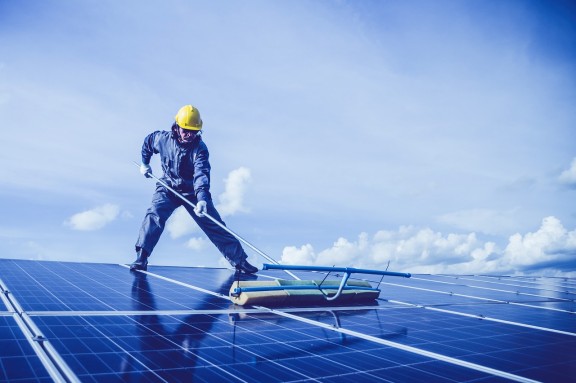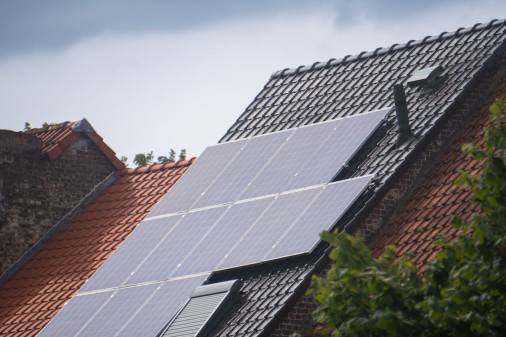EVA Sheets for Solar Panels (Complete Guide)
EVA sheets are a less obvious component of solar panels that should not be ignored. EVA sheets for solar panels have a significant role as the backbone ensuring the longevity, efficiency, and reliability of the panels. In this detailed full process explanation, the properties, functions, and importance of EVA sheets in the solar panels will be analyzed and the advancements that have taken place in the development of these sheets will be mentioned.
What Will You Learn?
In this blog, you will find necessary information about how Ethylene Vinyl Acetate (EVA) sheets are used in solar panel production and how they affect the photovoltaic panels’ performance. We will identify the qualities that make EVA sheets an excellent encapsulant: high clarity, elasticity, and UV stability. Also, you will learn about,
- the manufacturing process of EVA sheets
- the various types of sheets and where they are used especially in the solar industry
- the latest modern innovations of EVA sheets in matters concerning efficiency, durability, and any ecological concerns.
Table of Contents
In this blog, we will learn about the following:
- What are EVA Sheets for Solar Panels?
- Importance of EVA Sheets for Solar Panels
- Properties of EVA Sheets: Attributes That Make Them Suitable for Solar Panel
- Production of EVA Sheets for Solar Panels
- Types of EVA Sheets Used in Solar Panels
- Uses and Advantages of EVA Sheets for Solar Panels
- Interesting Developments in EVA Sheets for Solar Panels
- Frequently Asked Questions (FAQ)
- Summary
- Key Takeaways
What are EVA Sheets for Solar Panels?
EVA sheets have an essential role as an encapsulant material in solar panel production as Ethylene Vinyl Acetate, a polymer with properties like clarity, bendability, and strong bonding, forms these sheets.
Manufacturers sandwich EVA sheets between the photovoltaic cells and the glass cover lid as well as between the cells and the back sheet lid on the bottom. They serve as a barrier to protect and maintain the solar panel’s structure and longevity while also shielding the solar cells from physical damage, water, and fraud.
Importance of EVA Sheets for Solar Panels
EVA sheets serve a very important function in terms of fulfilling different applications and increasing the durability of the solar panels.
First of all, they serve as a substance through which mechanical loads and stress are taken and/or distributed, thus helping to shield highly sensitive photovoltaic cells. They help in identifying specific critical features that are vulnerable to physical damage during transportation and installation of solar panels.
Secondly, EVA sheets give a hermetic seal which helps in the protection from moisture and other environmental factors from getting to the solar cells. This sealing property is critical for the electrical insulation of the solar panel and for its proper working because the presence of moisture degrades the cells and the system’s performance as time passes.
Thirdly, EVA sheets play a role in the optical function of the solar panel. In addition, they also have high transmittance characteristics for the optical region, which means that maximum solar light can be transferred to the cells of the photovoltaic module. This feature is very crucial in order to achieve an efficient conversion of solar energy into electricity by the solar panel.
Properties of EVA Sheets: Attributes That Make Them Suitable for Solar Panels
EVA sheets have multiple properties that are fitting for its application in solar panels. Some of these properties include:
- High Transparency: EVA sheets possess good transparency, and as a result, the sheets can transmit a generous proportion of sunlight to the bottom-based photovoltaic cells. This is important in the achievement of high energy generation in the solar panel.
- Flexibility: EVA is a flexible material that helps a lot in ensuring that mechanical stress does not occur and consequently, no damages occur to the solar cells.
- Adhesion: EVA sheets adhere well to not only the glass cover of a solar panel but also the back sheet of the solar panel. This adhesion makes certain that the encapsulant shall stick to other components and create a firm base to the structure.
- Thermal Stability: EVA sheets are heat stable and do not undergo undesirable changes in form and mechanical characteristics in regions of high temperatures. The thermal stability of the materials used in producing solar panels plays a vital role in their efficiency and duration, especially when used in areas with hot climates.
- Electrical Insulation: The sheets offered in EVA can afford protection against short circuits and save the electrical energy diversion of the solar panel.
- UV Resistance: UV stability is a major factor when it comes to the degradation process as well as the discoloration of EVA sheets. This is relevant as it helps to keep the surfaces of the solar panel in question aesthetically appealing and optimally functional.
Production of EVA Sheets for Solar Panels
Various factors are involved in the production of EVA sheets to enhance the quality of the final product. The process typically includes:
- Mixing: The process combines ingredients like ethylene, vinyl acetate, and other additives to create a mixed blend.
- Extrusion: This blend goes through a flat die to form a sheet-like structure and by adjusting the extrusion settings, you can control the sheet’s thickness.
- Lamination: To protect the EVA sheet and make it easier to handle, it’s attached to a carrier film flowed by the usage of heat and pressure to ensure the sheet sticks.
- Curing: The laminated EVA sheet then undergoes a curing process that involves heating the EVA sheet to a specific temperature to kick off the cross-linking process and subsequently make the EVA sheet gain improved thermal and mechanical properties.
- Cutting and Packaging: After curing, workers cut the EVA sheet to the required size and then they pack it up to send to various markets.
Types of EVA Sheets in Solar Panels
In the case of EVA sheets which are used as encapsulating material in the solar panels, there are several types. Each of these types possesses unique characteristics and they are as follows.
- Standard EVA Sheets: These sheets are the go-to choice for making solar panels as they hit the sweet spot as a favorite of manufacturers.when it comes to being see-through, sticky, and bendable.
- UV-Resistant EVA Sheets: These sheets are tough cookies when it comes to UV rays, built to handle places where the sun beats down, and using these helps to keep solar panels from turning yellow or breaking down over time.
- PID-Resistant EVA Sheets: PID is an impairment factor that affects modules in solar systems by reducing their power output. EVA sheets that are resistant to PID are capable of reducing the PID impact thus the durability of the solar panel.
- Fast-Curing EVA Sheets: These sheets are developed to gel faster in the laminating process so that there will be a shorter working time in production, thereby improving production pace.
- Low-Temperature EVA Sheets: These sheets are more suitable for low-temperature lamination that results in less energy usage and hence, low production cost.
Uses and Advantages of EVA Sheets for Solar Panels
The use of EVA sheets in solar panels offers several benefits and applications, including,
- EVA sheets shield photovoltaic cells: They have an impact on the physical and chemical safety of these cells and safeguard them from mechanical harm, water, and pollutants, thereby extending the solar panel’s life and keeping it working at peak efficiency.
- Optical Performance: EVA sheets allow most sunlight to reach the panel’s photovoltaic cells, reducing the effect of anything that might block the solar pane, thanks to the high transparency of these sheets.
- Thermal Management: EVA sheets aid the solar panel parts with managing expansion or shrinkage as temperatures change, reducing mechanical stress on the product. The temperature in these areas changes a lot from season to season and this good thermal management solves it.
- Electrical Insulation: EVA sheets have good electrical insulating properties and can avoid short circuits which are dangerous to the functioning of the solar panel.
- Durability: The ability of EVA sheets to withstand weather conditions and ultraviolet light which could affect the look and efficiency of the solar panel in the duration of its use.
Interesting Developments in EVA Sheets for Solar Panels
The generation of EVA sheets for solar panels involves a strong growth area because more studies and developments are carried out to develop other innovations. Some of the recent advancements include:
- Advanced Cross-Linking Technologies: More investigation is being undertaken in the field on newer cross-linking agents so as to increase the thermal as well as the mechanical characteristics of EVA sheets. Consequently, science goals toward these improvements for solar panel design and construction, particularly the areas that are hard to fit with solar panel systems.
- Nano-Additives: Currently, nano-additives are examined as the possibility to improve the characteristics of EVA sheets with their further application.
- Biodegradable EVA Sheets: As the global environment consciousness escalates, the analysis of biodegradable EVA sheets’ development is rising. These sheets are intended to degrade at the end of their service life to help lessen solar panels’ effects on the environment.
- Improved PID-Resistance: New research is being carried out on efforts to produce new EVA sheets that are more resistant to PID. These advancements will help in reducing the possibilities of PID and will successfully provide efficiency and endurance to solar panels.
Frequently Asked Questions (FAQ)
They serve a number of purposes including safeguarding photovoltaic cells from mechanical destruction, electrically insulating them, and boosting the panel’s optical performance.
UV resistance prevents the degradation and yellowing of the EVA sheets over time. Moreover, this resistance helps to maintain the appearance and efficiency of the solar panel during its lifetime.
Yes, some organizations are working on the idea of biodegradable EVA sheets that aim at minimizing environmental damages associated with photovoltaic panels by making the encapsulant easily decompose when it reaches its lifetime.
Summary
EVA sheets are crucial components in solar panels that provide protection, and insulation and enhance the optical properties of PV cells. Their unique features such as high transparency, bendability, good adhesion, thermal stability, and UV resistance make them suitable for use under different environmental conditions. The manufacture of EVA sheets requires careful formulation and quality control to ensure their effectiveness in protecting and enhancing the performance of solar modules.
Recent advancements in these materials including advanced cross-linking technology, nano-additives, and the development of biodegradable EVA sheets have improved both the quality and sustainability of these materials. The role played by ethylene-vinyl acetate (EVA) in guaranteeing effectiveness, reliability, and longevity will be crucial even as the solar industry continues growing and maturing.
Key Takeaways
- EVA sheets play a key role in solar panels by shielding photovoltaic cells from physical harm, water, and pollutants.
- The clear nature of EVA sheets allows more sunlight to pass through, boosting solar panel output.
- EVA sheets can withstand high heat and resist UV rays, which helps them last longer and work better over time.
- New types of EVA sheets, like those that resist PID and are easily biodegradable, are tackling specific problems and green concerns in the solar field.
- As EVA sheet technology keeps getting better, it helps make solar panels more reliable and eco-friendly overall.






